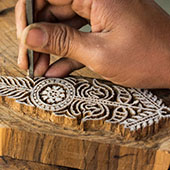.
Pethapur Block Making
There is more to a block than just a printing surface. Each of its anatomy and features has a function.
Handle of the Block:
The block's handle is called the Pakad or the Haatha, though it is just as common for artisans to refer to them as a handle nowadays. Handles are primarily of two types: handles carved from the same block of wood and handles attached to a motif carved on a wooden slab. The former was more common in the older days when Teak wood was abundantly available.
It is now more common to find blocks with the handles attached with screws or nails, especially if it has a large surface since carving a handle from such a block would take a lot of time and lead to wastage. Not only is the process of attaching a handle faster than carving out one, but it also requires less wood. This is especially important during present times since quality teak wood is hard to find. Simultaneously, the heartwood is used to make the block, the soft sapwood used for handles. Handles also have a groove on the left side of the handle since printing is typically done right to the left, and this acts as a guide for the printer in the printing process.
Repeat Points:
The artisan places repeat points on the four corners of the block to aid the printer with the blocks' alignment from one impression to another on a long stretch of the fabric. When the block is pressed on to the cloth, these points leave behind dots on the fabric. The printer then aligns the repeat points of the blocks over these dots successively. These dots can be used to easily tell apart whether the textile has been block printed or screen printed.
Pavansaars:
Blocks have a feature that allows air to pass through the block during the printing process. This is in the form of circular holes drilled through the design's closed spaces and connected to air passageways running under the length of the design called Pavansaars. When the block is pressed down on the fabric during the printing process, the pavansaars ensure that air is not trapped between the block and the fabric surface. Drilling Pavansaars is not an easy task, and at least in the past, it used to require two artisans operating a large saedi. Now, this can be achieved with a machine drill.
Side Faces of the Block:
Lastly, the shaping of the block, cut along the shape of the motif or given wavy edges on the two adjacent sides, provides the printer with an idea of the block's orientation and helps them maintain the consistency of the printing. This can be seen in the figure below, where two sides are flat, but the other two adjacent sides are unique.











